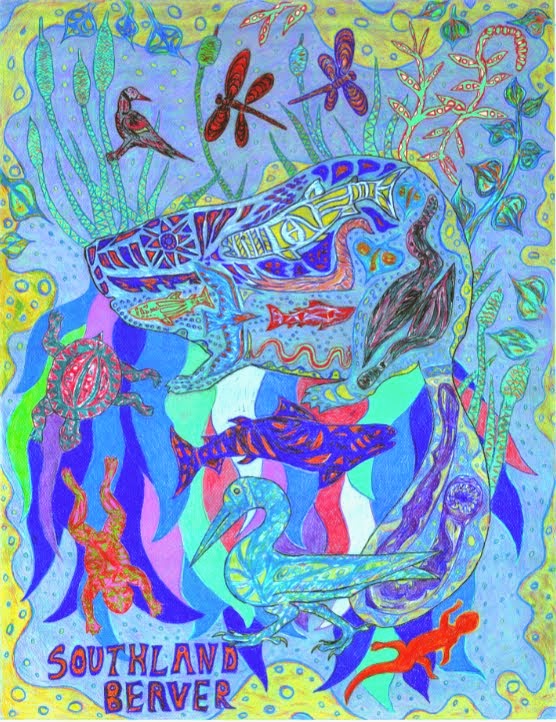That the Pacific Lamprey (Entosphenus tridentatus) is historically one of the more maligned native fish, and I use the term fish here loosely as lamprey pre-date fish, is in no small part due to it's grotesque appearance and parasitic adult stage. I want to highlight that it is the adult phase that is parasitic as the juvenile phase plays a not too small role in river ecology as we will talk about later. It should also be reinforced that the parasitic adult phase do not limit their feeding to salmonids but also latch onto marine mammals and other fish. And as the picture below, taken at about 400 meters deep in the Monterey canyon off central CA feeding on a hake, attests they range deep.
But they do not latch onto fish when they return to coastal river systems nor do they always kill their host. Lamprey prefer similar environments as salmon to return to and lay eggs. It is not clear if lamprey return to their natal streams but they range from Alaska to southern California. Like salmon they do not feed on their return migration. Unlike salmon lamprey can not maintain speed in high velocity channels for long and will swim at bursts and then sucker on to rocks/branches/debris to rest. But as the photo below attests this allows lamprey to traverse falls that even salmon can not get up such as in the pic of Willamete falls below. Unfortunately fish passages that work for salmon may fail for lamprey.
 |
| Williamette Falls lamprey harvest. credit Dave Herasimtschuck. Freshwater Illustrated |
"How do we let something- 450-500 million years old -go extinct? Shame on us, the whole lot of us for not paying attention to what was going on"
"We are a big family we are the circle. So when one of us is in trouble that is when the rest of us have to do something and step in"
"They amaze me, they are amazing creatures. My brother eel is cool- he is just flat cool."
So while native American cultures of the Pacific Northwest have long heralded lamprey as an important part of the their world the rest of us are slowly waking up to the importance of this creature. The USFW have actually created a cutesy cartoony lamprey character "Luna the Lampery" for lamprey awareness.
Check out their page The Pacific Lamprey Experience. Lamprey may be so important that their continued survival may be pivotal to the health of salmon fisheries. How is that so? you might be asking They parasitize and sometimes kill salmonids?
Turns out the lamprey youngsters, which are called ammocoetes, are not parasitic at all. In fact they do not even eat flesh- they filter the water, cleaning up algae, detritus and other bits from the water - and also burrow into the substrate. For these reasons they are often dubbed the earthworms of the river.
At this stage, which may last 7 years, ammocoetes serve as food for a number of critters- especially salmonids. There are loads of examples of steelhead stomachs being found just crammed with these guys. So although later they parasitize salmon, for the majority of their life they serve as food for them. And through their filter feeding abilities they promote cleaner, and therefore more well oxygenated environments that we all know salmonids love.
As adults lamprey returning to spawn also may actually help salmonids. Because their flesh is richer and oiler than salmon and they are easier to catch than salmon- predators may preferentially take lamprey thus acting as a buffer to salmon predation where their migrations are coincident.
And finally after returning lamprey spawn and die their bodies can provide nutrients that promote an enriched food chain for salmon fry.
And now let us all tie it all back together with the beaver. From the USFW page on lamprey: Shortly after hatching in freshwater streams, lamprey larvae or ammocoetes drift downstream into areas of low velocity and fine substrates where they burrow, and live as filter feeders for up to 7 years. Hmmmm..... low velocity and fine substrates..... where might we find such habitat? Does anyone know of certain buck-toothed rodent that might actually create such habitats?
 |
| Beaver side channel pond. Santa Ynez river |
Yes salmon need lamprey and both salmon and lamprey need beaver.
 |
| Randy L. Rasmussen. The Oregonian |
Support me on Patreon.
Like antediluvian salad on facebook.
Watch me on Deviantart @NashD1.Subscribe to my youtube channel Duane Nash.
My other blog antediluviansalad.blogspot





Fascinating!
ReplyDeleteVery kool. Although I've known of them, I've never actually taken the time because they were never something I dealt with where I came from I guess. Thanks for that info. Life for creatures in Southern California really stinks, no matter what the creature.
ReplyDelete